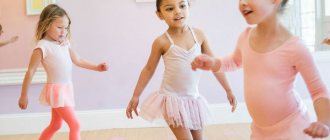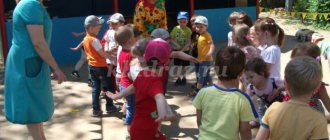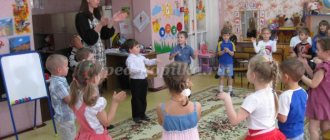Senior group. Senior preschool age. Children 5-6 years old
Video MK "Spanish Dance" for children of senior preschool age
Video MK "Spanish Dance" for children of senior preschool age Today our lesson is devoted to such a wonderful genre as dance. Who among us doesn't love dancing ! Everyone loves it! We like dances for children and youth , modern ballroom and pop.
We are happy to watch... Video recording of a choreography lesson with children of senior preschool age
In the work program for direct educational activities in choreography with children of senior preschool age there is a section - “Working with the subject.” I chose the topic - working with pom-poms. They are bright in appearance, and children are enthusiastically engaged with them. The purpose of the lesson is…
Project in kindergarten on the topic Dance. Senior group
Project for the development of children's dance creativity "Magic dance movements"
Place of implementation of the project: Russia, Saratov region, Krasnoarmeysk city, MBDOU "Kindergarten No. 14", senior group No. 3 "Pinocchio". Project type: creative. Project participants: children of the senior group, teacher. Implementation period: September 2022 – May 2019 academic year. 1. Introduction Relevance. Dance is one of the types of art that is an effective artistic and aesthetic means of musical, plastic, physical development and moral and ethical education of a preschooler. The peculiarity of dance in an artistic image, which is embodied only with the help of expressive and special movements of the dancers, without any verbal explanations, which corresponds to the motor nature of children's creativity, which is characterized by the effective recreation of images by children “with the help of their bodies.” In dance, more than in other types of children's musical activities, creative imagination develops. Musical accompaniment of different types of dances develops children's musicality, love of music and shapes children's aesthetic taste. Having studied the literature on the development of dance creativity, I came to the conclusion that with the help of dance creativity it is possible to solve some of the problems that arise in children of senior preschool age (self-doubt, stress caused by emotional imbalance). As a result, dance can be considered as a way of self-expression, communication (communication) and socialization; harmonization of physical condition and spiritual world. Problem. Observing children who are taught musical and rhythmic movements, despite their good level of development, I came to the conclusion that dance improvisations are monotonous and not original; children do not experience pleasant emotionality, they are tense and seem to be afraid to deviate from the learned movements, they cannot independently come up with their own variations of movements. This is the reason for the relevance of this project topic. Hypothesis. The formation of children's dance creativity will become more effective if dance and musical-rhythmic movements are constantly used in different types of musical activities; use a diverse combination of all methods and forms and techniques of OOD for the development of dance creativity; develop interest in dancing; improve the psychophysical qualities of children. The goal of the project is to develop the creative abilities of children of senior preschool age through musical, rhythmic and dance movements. Project objectives: 2. To develop in children the ability to invent simple dance movements using familiar ones. 3. Develop the emotional state of children while performing dance movements. 4. To promote the development of the ability to find one’s own, distinctive movements to express the character of music 5. To foster a desire for self-realization in movement to music. Expected results for the project: Children mastering new motor skills;
Unlocking children's creative abilities; A significant increase in the level of musical and rhythmic training and development of the emotional sphere of children. Formation of interest in practicing musical-rhythmic movements and dances, the need for constant motor activity; Formation of personal communicative qualities. Analysis of the initial monitoring data obtained showed that the level of development of children's dance creativity is quite low, i.e. I set myself the task of developing a system of work to develop children's creativity. Stages of the project
1 preparatory stage. Studying methodological literature on this topic. Preparation of necessary materials and equipment. Consultation for parents. Carrying out introductory diagnostics, main stage 2. Practical. Drawing up a long-term plan. Drawing up notes of holidays and entertainment that contribute to the implementation of project objectives. Carrying out creative minutes during which children independently come up with new movements. Children's participation in creating new dance compositions. Assess your personal participation in the process of dance creativity Children's dance creativity is impossible without the development of musical and rhythmic movements. Musical-rhythmic movements are the most productive type of musical activity, with the help of which musical creativity and creative qualities of the individual are formed. At the first stage, children were offered figurative dance exercises and sketches, which contribute to the development of plasticity and creativity, the emancipation of children who are invited to transform into one or another image. In this case, not only pantomime is used, but also the language of gestures and facial expressions. Next, children are asked to master the main types of musical and rhythmic movements: various types of walking, running and jumping. After this, children develop orientation in space, formation, development of dance movements, plasticity, expressiveness of performance, and dancing. Particular attention is paid to the individual creative expression of children in sketch games, improvisation games, and dance improvisations. Thus, in children, in the process of dance creativity, a positive sense of self is strengthened, which is associated with a state of self-confidence, liberation, positive self-esteem, and importance in the children's team. Plot sketches can be divided into the following types: Dynamic sketches allow you to reveal a situation, a plot in development, for example: “Skiing”, “Playing snowballs”, “Collecting berries”, “Sly little fox”, etc. In the work on creating a dynamic sketch, several stages can be distinguished: - creating a figurative image: “Bunnies are jumping”, “A fox is running”, - creating a figurative image in contrast: “The bear is sleeping” - “The bear is picking mushrooms”, - creating an expressive image: “ The cat is sick”, “Sunny Bunny”. Static studies. It is easiest for children to create and depict an image from an illustration (picture) with musical accompaniment: “The doll is sleeping,” “The soldier is standing,” “The dog is resting.” Position studies are performed with interest by children of primary preschool age. They give the child the opportunity to independently come up with a composition, using life experience in accordance with age: “A bird sits on a branch,” “The sun is smiling.” To create an expressive static image, it is necessary to develop facial expressions and general plasticity, as well as coordination of movements. Transitional studies from dynamic to static . Game “Freeze”, “The sea is agitated once”. According to the conditions of the game, the types of movements alternate. This type combines the expressive capabilities of dynamic and static studies. For this type of creative tasks, preference is given to bright, visual music. The teacher’s task is to help the child with high-quality and expressive improvisation on the piano. Creative games also include special theatrical games for children or creative sketches. This is a small performance in which a certain event should take place in expected situations, circumstances, conditions. Guess what I'm doing Purpose:
explain a given pose, develop imagination, memory.
Move:
the teacher suggests taking a certain pose and explaining it.
1. Stand with your hand raised. Possible answers: putting a book on a shelf, hanging a jacket, decorating a Christmas tree, etc. 2. Stand on your knees, arms and body pointing forward. I'm looking for a spoon under the table, watching a caterpillar, feeding a kitten. 3. Squat. I look at the broken cup and draw with chalk. 4. Lean forward. I tie my shoelaces, pick up my scarf, and pick a flower. The same thing in different ways Goal:
to develop the ability to justify and explain one’s behavior, one’s actions with fantasized reasons suggested by circumstances, to develop imagination, faith, fantasy.
Move:
children are asked to come up with and show several options for behavior for a specific task: a person walks, sits, runs, listens, etc.
Each child comes up with his own behavior, and the other children must guess what he is doing. Children are divided into 2-3 creative groups, each receiving a specific task. 1 - sit. Options: sitting in front of the TV, in the circus, in the dentist’s office, etc. 2 - go. Options: walk along the road with puddles and mud all around, along hot sand, along a narrow bridge, along a mountain path. 3 - run. Running, being late for the theater, from an angry dog, getting caught in the rain, etc. Transformation of an object. Goal:
to develop intelligence, imagination and fantasy.
Move:
the object is placed on a chair in the center of the circle or passed from one child to another.
Everyone must act with the object in their own way, justifying its new purpose. Options: 1. pencil or stick - key, screwdriver, fork, toothbrush 2. small ball - apple, shell, snowball, chicken, bun 3. notebook - mirror, soap, chocolate, shoe brush. Games with imaginary objects. King Goal:
to develop actions with imaginary objects, the ability to act in concert.
Progress:
a child is chosen to play the role of king.
The rest are workers, they agree among themselves what they will do, what work they will be hired for. They approach the king. - Hello, king! - Hello! - Do you need workers? - What can you do? - you guess it! Children, acting with imaginary objects, demonstrate various professions: cooking, washing, embroidering, watering flowers, etc. The king must guess. If he does it correctly, he will catch up with the children. The first child caught becomes king. Birthday Goal:
to develop skills in acting with imaginary objects, to cultivate goodwill and contact in relationships.
Move:
a child is selected who invites the children to the birthday party.
Guests come and bring imaginary gifts. The birthday boy (and other guests) guess. We won’t say what we did, but we will show you. You can offer the following tasks: washing hands, drawing, washing a scarf, rocking a doll, etc., as well as performing paired and group tasks: playing ball, pulling a rope, passing a bowl of fruit. Topics should be close and understandable to children - Quarrel, Meeting, Getting to know each other, Treating, Talking on the phone, etc. When writing a sketch, children must answer many questions: where am I, where did I come from, why, when, why. We offer studies on basic emotions: Sadness, Anger, Joy, Surprise, Fear. You can use five senses: Hearing, Vision, Smell, Touch, Taste. For example, taste a bitter medicine or candy; smell the paint, the cake being cooked. 3 final stage. Analytical. Final diagnostics. Project results. Prospects for further development on this topic. Forms of work: - subgroup work - individual work with passive, shy, hyperactive children - parent meetings As a result of the project, students became more active in creative development. They became more flexible and relaxed, which had a positive effect on the development of creativity. Movements in dance compositions have become more precise in execution, and also, children more often began to have a desire to introduce something new into gestures and facial expressions. Conclusions. While implementing the project, the children fully developed their imagination, supported by learning experience. Sometimes, it happens, I have to be surprised at the originality of children's decisions, which turn out to be no less, and sometimes even more successful and organic than my own preparations. At such moments, I try to listen to children in their creativity and even learn from them. The development of children's dance creativity has improved and led to excellent results, since pedagogical activities in musical-rhythmic movements and dances are implemented in accordance with their abilities and preparedness. This is evidenced by the results of the final monitoring. Children's skills in performing dance movements have strengthened, children began to understand their meaning, and are able to express their attitude and mood with the help of these movements. Children's ability to convey a musical image in plastic using musical and rhythmic movements has developed. The ability to compose simple dance compositions using familiar musical and rhythmic movements has been developed. The emotional sphere of children has developed. Summing up the work done , we can say that the development of children's dance creativity has improved. The successful completion of this important task is facilitated by the characteristic abilities of children of this age: increased susceptibility, impressionability. Based on the results of the project activities, it can be noted that children are fully prepared to solve problems on this issue if methodologically competent, systematic work is carried out on the part of the leader in close cooperation with the families of pupils and teachers of the preschool educational institution. In my future professional activities, I plan to continue working on the development of children's dance creativity, to use information forms (the use of computer technologies in direct educational activities and in free activities); continue interaction with the families of pupils. References 1. A. V. Zaporozhets, Ya. Z. Neverovich, A. D. Kosheleva, etc. Edited by A. D. Kosheleva Emotional development of a preschooler. Moscow, Education, 1985 2. Burenina A.I. Rhythmic mosaic: (Rhythmic plasticity program for children of preschool and primary school age). - 2nd edition., rev. and additional – St. Petersburg: LOIRO, 2000 3. V. G. Gorshkova Learning to dance. The path to creativity Moscow 1993 4. V. N. Shatskaya Musical and aesthetic education of children and youth Moscow, 1975 5. E. I. Yudina My first textbook on music and creativity Moscow, Aquarium 1997 6. Internet resources 7. Madorsky L., Zak A. Musical education of a child Iris-press, Moscow, 2011 8. Novikova G. P. Musical education of preschool children: A manual for practical workers of preschool educational institutions. Moscow, ARKTI, 2000 9. O. A. Kurevina Synthesis of arts in the aesthetic education of preschool and school-age children. Moscow, LINK-PRESS, 2003 10. O. P. Radynova Musical masterpieces Moscow, Gnome-PRESS, 1999 11. O. P. Radynova, A. I. Katinene, M. L. Palavandishvili Musical education of preschool children Moscow , Education, 1994 12. Program “Childhood” Childhood with music A. G. Gogoberidze, V. A. Derkunskaya St. Petersburg Childhood-PRESS, 2010 13. S. D. Rudneva, E. M. Fish Rhythmics . Musical movement. Moscow, 1972 14. S. I. Bekina Music and movement Moscow Enlightenment 1983 15. T. E. Tyutyunnikova Under a solar sail or flight to another dimension. Theory and practice of primary music education. St. Petersburg, Publishing House "Musical Palette", 2008 16. T. E. Tyutyunnikova I am learning to create. Elementary music-making: music, speech, movement" Moscow, 2009
We recommend watching:
Project in kindergarten for older preschoolers 5-7 years old on legal topics. Entertainment program in kindergarten. Scenario Summary of the final lesson of vocal and dance clubs in kindergarten Scenario of a game lesson for older preschoolers “Rhythmic men”
Similar articles:
Project for children of the senior group “Our cheerful garden”


